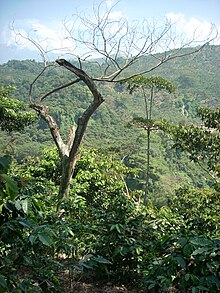Coffee production in Guatemala

The coffee production in Guatemala is an important part of the Guatemalan economy. While the country was Central America's top producer of coffee until for most of the 20th Century and the beginning of the 21st Century, the coffee production in Honduras surpassed Guatemala in 2011.[1] However, there are also illegal exports to Honduras and Mexico and earnings from illegal trade are not reflected in the official statistics.[2]
Geography
The most suitable temperature for the healthy growth and abundant production of coffee in Guatemala is that of 60° to 90° F. In lands situated at an altitude of 500–700 metres (1,600–2,300 ft) above sea level, young plants must be shaded. In zones averaging an altitude of 1,500 metres (4,900 ft), the plantations must be sheltered from the cold north winds. For the most part, the coffee plantations are situated at an altitude varying from 500–5,000 metres (1,600–16,400 ft) above sea level. [3]
History
The coffee industry began to develop in Guatemala in the 1850s and 1860s, initially mixing its cultivation with cochineal. Small plantations flourished in Amatitlán and Antigua areas in the southwest.[4] Initial growth though was slow due to lack of knowledge and technology. Many planters had to rely on loans and borrow from their families to finance their coffee estates (fincas) so coffee production in the country grew increasing non-Guatemalan, owned by foreign companies who possessed the financial power to buy plantations and provide investment.[4]

The scarcity of laborers was the main obstacle to a rapid increase of coffee production in Guatemala. In 1887, the production was over 48,500,000 pounds; in 1891, it was over 52,000,000 pounds. From 1879 to 1883, Guatemala exported 293,274,971 pounds of coffee. By 1902, the most important coffee plantations were found in the southern coast. Many acres of land were suitable for this cultivation, and the varieties that were produced in the temperate regions were superior. Coffee was grown around Guatemala City, Chimaltenango, and Verapaz. The majority of the plantations were located in the departments of Guatemala, Amatitlan, Zacatepeques, Solola, Retalhuleu, Quezaltenango, San Marcos, and Alta Vera Paz.[3]
References
- This article includes text incorporated from Pan American Union's "Coffee: extensive information and statistics" (1902), a publication now in the public domain.
- ^ Guerrero, Jean (July 29, 2011). "A Prince of the Coffee Bean Honduras Becomes Central America's Top Producer, Helping to Fuel Its Economy". The Wall Street Journal. Retrieved 16 November 2011.
{{cite news}}: Italic or bold markup not allowed in:|publisher=(help) - ^ Information Services on Latin America (Oakland, Calif.) (January 1986). ISLA. I.S.L.A. Retrieved 20 November 2011.
- ^ a b Pan American Union (1902). Coffee: extensive information and statistics (Public domain ed.). Govt. Print. Off. pp. 21–. Retrieved 16 November 2011.
- ^ a b Clarence-Smith, W. G.; Topik, Steven (2003). The global coffee economy in Africa, Asia and Latin America, 1500-1989. Cambridge University Press. p. 191. ISBN 978-0-521-81851-3. Retrieved 20 November 2011.

